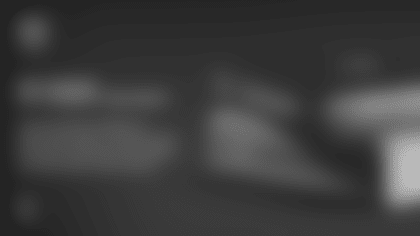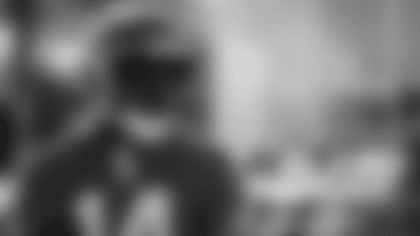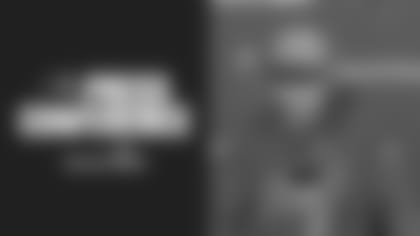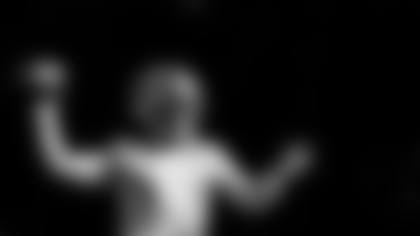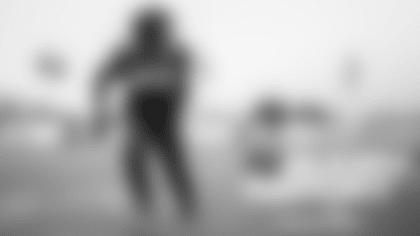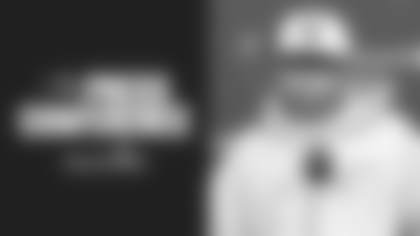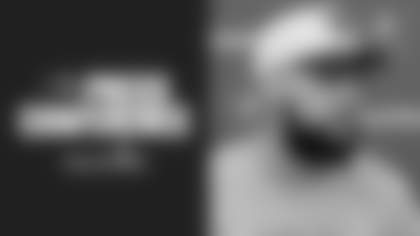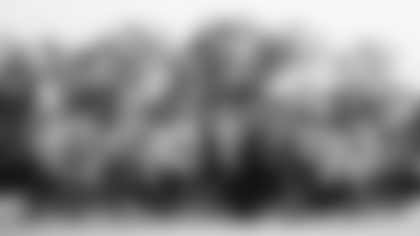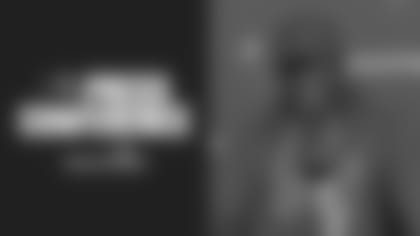College scout Dennis Hickey (foreground) and Director of Pro Personnel Mark Dominik check out a list of names in the Bucs' draft room
Just about everywhere but Tampa, it was an eventful first round in the 2003 NFL Draft.
Five trades were consummated in the four hours and 58 minutes that elapsed between the Cincinnati Bengals going on the clock and the Oakland Raiders making pick number 32.
The deals started almost immediately, with pick number six going from the Arizona Cardinals to the New Orleans Saints roughly an hour into the proceedings. The Saints moved up 11 spots and grabbed DT Johnathan Sullivan and the Cardinals netted an extra first round pick, an improved spot in the second round and an additional fourth-rounder.
Other teams that moved up in the first round included New England (one spot to number 13 to take DT Ty Warren), Philadelphia (15 spots to number 15 to take DE Jerome McDougle), Pittsburgh (11 spots to number 16 to take S Troy Polamalu) and Baltimore (22 spots to number 19 to take QB Kyle Boller). Their trade-down partners were, respectively, Chicago, San Diego, Kansas City and New England.
Perhaps the most dramatic of those trades was Baltimore's, as the Ravens surrendered their 2004 first-round choice (as well as their 2003 second-rounder) to the Patriots in order to secure the player they hope will be their franchise quarterback. Many mock drafts had predicted that very Ravens-Boller matchup, but at the 10th overall spot. Baltimore still got their man while using that earlier pick to snag the extraordinary Arizona State pass-rusher, DE Terrell Suggs.
Suggs was not the first defensive linemen taken, however. Not even close. After the expected three offensive players opened the round (QB Carson Palmer to Cincinnati, WR Charles Rogers to Detroit and WR Andre Johnson to Houston), four of the next seven picks were defensive linemen, beginning with Kentucky DT Dewayne Robertson, who went to the New York Jets. The Jets had traded up to that spot with Chicago on Friday evening, surrendering two picks later in the first round.
In fact, half of the first 18 picks were defensive ends or tackles, and a total of 11 defensive linemen went in the opening round, a draft record. The next most popular position was cornerback, with five selected.
Chicago used its two picks acquired from the Jets, after that small move from 13 down to 14, to take Penn State DE Michael Haynes and Florida QB Rex Grossman. The other teams with two picks in the first round were Baltimore, Arizona (WR Bryant Johnson, DE Calvin Pace) and Oakland (CB Nnamdi Asomugha, DE Tyler Brayton).
The fascinating Willis McGahee issue was finally resolved at pick number 23, when Buffalo took the Miami running back off the board. Despite a serious knee injury suffered near the end of the January 3 Fiesta Bowl, McGahee's stock rose rapidly in the weeks before the draft, to the point where many expected him to move back into the first round. That proved true, but not to one of the teams with which pundits had expectantly matched him. McGahee was the first running back taken, and one of only two to go in the first round, as Kansas City selected Penn State's Larry Johnson in the 27th slot.
The first round was also not without controversy. For the second straight season, a team failed to pick during its prescribed 15 minutes and 'passed' to the next club on the clock. Last April, time expired on the Kansas City Chiefs at pick number six, a spot they had just moved into via a trade with Dallas. The Chiefs, however, were able to get their card in for DT Ryan Sims before the next team, Minnesota, could jump over them.
This year it was Minnesota that ran out of time, at pick number seven. Jacksonville then rushed in its selection for QB Byron Leftwich and Carolina followed quickly with T Jordan Gross before the Vikings finally exercised the number nine pick on DT Kevin Williams. Afterwards, both Baltimore and Minnesota indicated that they had agreed on a trade of the seventh and 10th picks but were unable to get it into the commissioner on time.
The second round of the 2003 draft began at 5:06 p.m. ET, and this time it was one that would involve the Buccaneers. Tampa Bay is scheduled to pick at number 64, the last selection of the second round.



